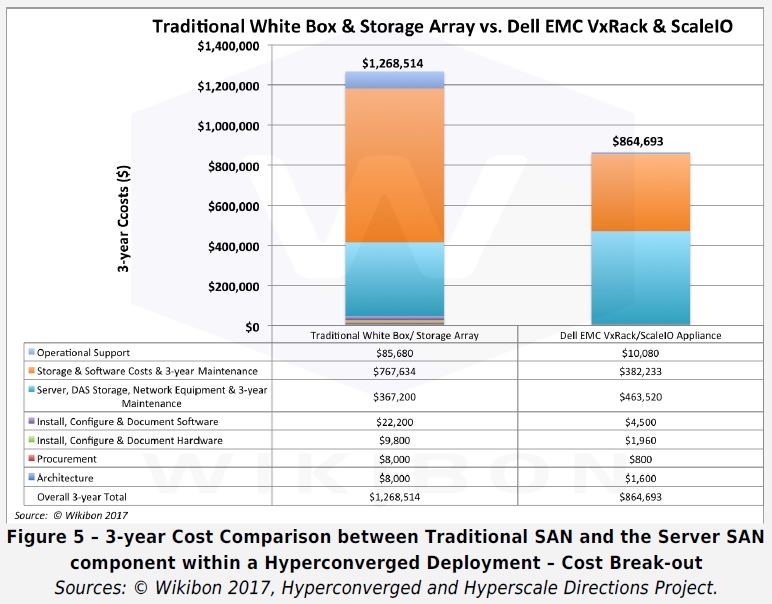
Earlier this year, Wikibon proposed a theory that “the optimum hybrid cloud strategy” is based on an integrated hyper-converged infrastructure (HCI) as opposed to the traditional enterprise architecture built on separate servers and separate traditional SAN.
To test and validate their premise, Wikibon experts performed a three year comparison of a traditional white box / storage array vs. a hyper-converged system. The hyper-converged system they selected was Dell EMC’s VxRack FLEX, which is based on ScaleIO software-defined storage. Through their research, they were able to analyze and compare costs across these four main categories: initial investment, time-to-value, cost over time and ease of use.
While you can read all the details on the approach and methodology for comparing these two instances in the full report here, I’d rather jump right into the juicy stuff: the results!
Initial Investment
The initial investment for a traditional SAN solution was $734K versus $405K for a hyper-converged system. To give you the full picture, there are several reasons why HCI solutions are less expensive to purchase up front. Not only are the equipment costs lower (storage arrays are replaced with DAS and specialized Fibre Channel networking and HBAs are no longer required), but most customers only buy what they need for the short term rather than over purchasing infrastructure to support unknown future requirements, which is common when the infrastructure is intended to last for multiple years. That’s the power of HCI – it enables you to start small and grow incrementally as your demand for resources increase. But the savings and cost discrepancies didn’t stop there.
Time-to-Value
Practitioners who took part in deploying the solutions onsite found that it took 33 days to configure, install and test the traditional white box/storage array as opposed to the hyper-converged infrastructure which took a mere 6 days. The time-to-value for hyper-converged was then calculated to be 6x faster. This is one of the key benefits of an engineered system. IT no longer bears the burden of architecting the solution, procuring separate hardware and software from multiple sources, and installing and testing the configuration before migrating workloads to production. Instead, the system is delivered pre-integrated, pre-validated and ready for deployment.
Cost Over Time
In addition to the upfront costs, the three year comparison then showed maintenance and operational expenses increasing the total cost for a traditional storage array to $1.3 million while maintenance and operations costs for hyper-converged came out to a total of $865K over three years. The main driver behind the savings is that HCI solutions greatly simplify IT operations in a number of ways: HCI provides a more efficient environment for those responsible for managing and provisioning storage; the ease of provisioning storage enables application developers to do more; and automation, streamlined provisioning, and higher reliability saves IT staff time on activities such as data migrations and capacity planning. There are also substantial savings from lower operating expenses such as power, cooling, and data center space. Other staggering numbers from the study included the following:
- Traditional solutions are 47% more expensive than a hyper-converged solution
- Storage costs for the traditional approach are 100% higher
- Overall, a hyper-converged solution is $400K less expensive
Ease of Use
In this last category, all practitioners interviewed, except one, agreed that the hyper-converged solution was easy to upgrade (more so than the traditional architecture), easy to manage and that it performed well. This makes sense given that HCI is typically managed from a central console that controls both compute and storage and automates many traditional manual functions, helping to reduce the number of tools that have to be learned and used. HCI systems also have full lifecycle management – meaning they are fully tested, maintained, and supported as one system over the entire lifespan. As a result of these efficiencies, people costs for HCI are much lower than the traditional approach. In fact, over a three year time span, people costs are 600% higher for traditional SANs.
So, when looking at the TCO breakdown, it looks like hyper-converged is the way to go over a traditional storage approach. HCI offers lower equipment and operational costs, lower latency and faster bandwidth infrastructure, as well as a “single hand to shake and a single throat to choke” for vendor support and service needs.
Dell EMC’s VxRack FLEX is a fully tested, pre-configured, hyper-converged system that meets all of these criteria while offering extreme scalability (start small and grow to 1,000+ nodes). It truly provides a turnkey experience that enables you to deploy faster, improve agility and simplify IT. You can download the report here to read about all the findings from the research or you can skip right on over to the Dell EMC VxRack website to start exploring your options.
